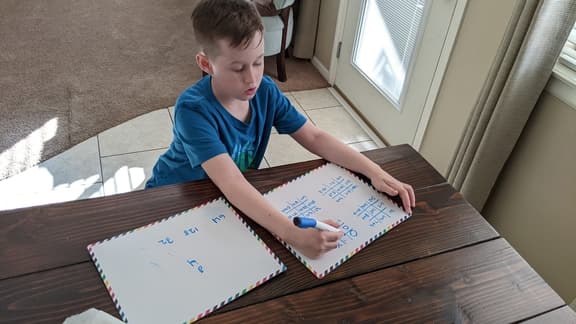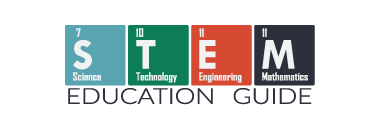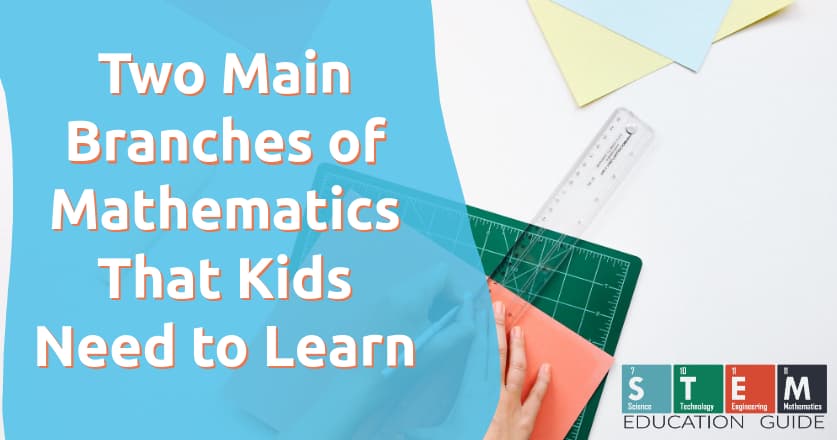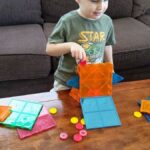Let’s face it. A well-organized world without the use of mathematics is unimaginable. Numerical analysis is a skill used in a multitude of ways.
Therefore, it’s no surprise that a wealth of mathematical branches exists in the world today. Nowadays, a mathematics study from the basics to advanced levels that contribute to technology, medicine, engineering, and more.
Understanding the different branches of mathematics and different mathematical concept models is an essential skill for students. In this guide, we’ll look at the two main branches of math that your kid needs to know.
Table of Contents
What Is Mathematics?

Mathematics can be defined as the science of space, quantity, and number, as theoretically applied to other fields or as abstract concepts.
As the science of relation, structure, and order, mathematics has advanced from elemental practices of measuring, counting, and shape description.
It encompasses quantitative calculation, real analysis, and logical reasoning. Furthermore, the development of mathematics entails increasing the level of idealization of its subject matter.
Branches of Mathematics
It’s no secret that mathematics has broadened over the years. It can be categorized into two main branches.
1. Pure
It’s the fundamental study of mathematical concepts and came about to solve a boatload of problems in the real world. Pure mathematics is used to study a wealth of concepts outside the realm of mathematics and can be subdivided into the following branches.
Algebra
This is the study of mathematical symbols and the rules for manipulating them. It ranges from solving the study of abstractions to elementary equations.
Elementary algebra is the most fundamental and the most abstract algebra is modern algebra. Elementary algebra is crucial for the study of engineering, science, medicine, and economics.
Similarly, modern algebra is a major field in advanced mathematics and is mostly studied by a professional mathematician. Examples of algebraic formulas are:
A2 – B2 = (A – B)(A + B)
(A – B)2 = A2 – 2AB + B2 (A – B)2 = A2 – 2AB + B2
A2 + B2 = (A + B)2 – 2AB
(A + B + C)2 = A2 + B2 + C2 + 2AB + 2BC + 2CA
If you’re looking for a good book to help kids with algebra, check out this book.
—-Make sure to check out our article, 10 Exciting Mathematics Review Games for Kids to Skyrocket New Math Skills On-The-Go.—-
Geometry
This study deals with the sizes and shapes of figures along with their properties. Geometry encompasses lines, solids, points, shapes, angles, and surfaces. Each industry applies geometry to fulfill its daily requirements.
Furthermore, when you’re moving from one place to another, you use geometry to find your way (GPS). Below are some basic geometry formulas.
Perimeter of a Rectangle = P = 2(l + b)
Area of a Rectangle = l x b
Area of a Triangle = ½ x b x h
Area of a Circle = π x r2
Circumference of a Circle = 2πr
Area of a Trapezoid = ½ (b1 + b2) x h
The Curved Surface Area of a Cylinder = 2πrh
Volume of a Cylinder = πr2h
Total Surface Area of a Cylinder = 2πr(r + h)
If you’re looking for a good book about geometry for younger kids, I recommend this one.
Trigonometry
This entails the study of relationships between sides and angles of triangles. There’s a direct relation between trigonometry and geometry.
After all, when the world was on the quest for a solution that was unsolvable via geometry, algebra, and arithmetic, trigonometry was birthed.
For trigonometry, you should take a look at this step-by-step guide.
Calculus
Calculus calculates the immediate rates of change and is used for infinite series, derivatives, limits, integrals, and functions. Additionally, calculus comes in handy for the summation of small factors used to determine the whole number.
Check out this book for middle schoolers to get a better hold on calculus.
Number Theory
As one of the crucial branches of pure math that kids need to learn, number theory involves the study of integer-valued functions and integers.
In addition to that, kids learn about whole and natural numbers. They also get to know twin primes (numbers that differ by exactly 2) as listed below.
41, 43
29, 31
11, 13
5, 7
17, 19
3, 5
Arithmetic
As the oldest branch of mathematics, arithmetic encompasses odd, even, and prime numbers. Kids learn the fundamental operations of multiplication, addition, subtraction, and division of numbers.
Arithmetic is used by everyone from working professionals to students, making it the foundation of pure mathematics. It’s also useful in performing basic calculations in your day-to-day.
To help kids with prime numbers, I recommended this book for them.
—-We have a great article about cool math tricks that kids will love. I know my kids have a lot of fun with these tricks.—-
2. Applied
Also referred to as advanced math, applied mathematics encompasses numerical computations in computer science. It’s used to express mathematical problems in some of the most amazing technologies such as simulation and modeling. Applied mathematics can be categorized into the following branches.
Probability and Statistics
These are interrelated and are an essential component of applied math. Probability involves the study of uncertain knowledge and events. It’s used to conclude unknown data.
Whenever you’re making predictions, probability comes in handy. In contrast, statistics is the scientific aspect of it. It’s useful in collecting and analyzing data based on stipulated criteria.
I found this excellent book for data analysis and probability.
—-If you’re looking for more STEM Education statistics, please take a look at our guide here.—-
Differential Equations and Dynamical Systems
When you want to study the derivatives of unknown functions, differential equations are the go-to. On the other hand, dynamic systems have fixed rules.
They are used to describe the water flow in a pipe, the swinging pendulum of a clock, and other naturally dynamic things.
Mathematical Physics
There’s no denying that mathematics is used in physics. As a result of its evolution, mathematical physics is effective in solving the multitude of problems in physics.
Nowadays, it’s used in some of the applications that revolve around physical theories. After all, derivatives, integration, integrals, and differentiation are widely used concepts in physics.
Computation
Mathematics is used in computer science as a branch known as computation. It involves the study of engineering, data structure, algorithms, and scientific computing science.
In addition to that, computation entails the use of mathematics to solve an array of computer science problems. The fields of computing and mathematics intersect in scientific computing and the study of algorithmic methods for solving problems in engineering, science, data structures, and mathematics.
Signal Processing and Information Theory
As an essential branch of applied mathematics, information theory is used to quantify information by finding the most ideal ways of sending reliable data efficiently.
On the other hand, signal processing is popularly used for the analysis, interpretation, and signaling of manipulations. It’s used for a boatload of signals such as radar and biological.
Processing these types of signals entails noise reduction compression, reconstruction, filtering, and other techniques.
—-If you’re brushing up on your math skills, computer science can help focus on that. Please look at your article, What Is Computer Science For Kids? How to Get Kids Started Coding. —-








